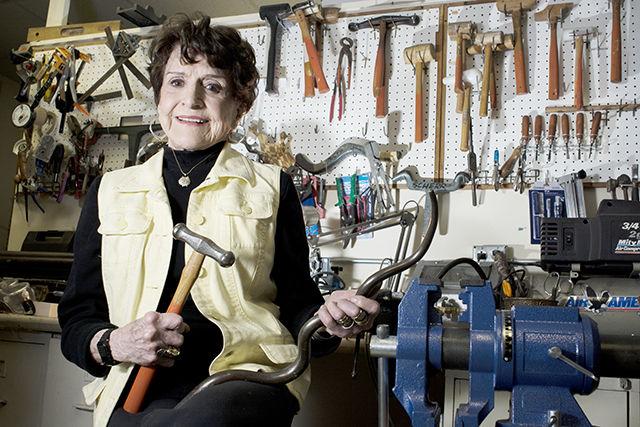NC State’s Crafts Center boasts a metal instructor who has worked in a multitude of industries and museums all over the world, who has a unique and interesting past with the World War II home-front efforts, who has won innumerable awards, and overall, and who has quite a story to tell.
Mary Ann Scherr is an artist, designer, educator, and metalsmith. From automobile design with Ford Motor Company to toy design, from fashion design and book illustration to experimental metal research and product development, Scherr is truly a jack of all trades.
Scherr began her career as an artist at the Cleveland Art Institute. She studied to be a graphic designer and started her career as a cartographer. Scherr will tell you that a career rarely turns out how a person imagined it.
“As a teacher, all I tell students is to study hard and be prepared because you never know where your talents are going to take you,” Scherr said. “It doesn’t always follow ‘what you study is what you’re going to get, or even want.’”
During World War II, she also worked for the Navy department developing charts that would discuss the progress of B29s and other fighter planes.
“I got into the employee incentive department and I worked on inviting special military people to talk to people who were working for the war effort,” Scherr said. “We had all types of special parties and affairs. Movie stars would come as part of the employee incentive program. It was very social type of wartime effort.”
At the end of the war, she left for Chicago where she became a graphic designer for a major company. When Scherr married, she moved to Detroit where she and her husband opened a design company, and the couple traveled all over the world working with all types of disciplines.
“When I became a mother, I discovered that I hated housework and I decided I better take a night class, and the only class I had never studied was metalworking,” Scherr said. “I always planned on being in product design. I never thought I would become a metalsmith.”
Scherr remembered how she discovered a knack for metalworking in the early 1960s while interacting with a woman who had a tracheostomy tube.
“It was so ugly, I could barely look at her while we were talking, so I asked if I could take it and redesign it for her,” Scherr said. “That set me in motion to start doing ‘cosmetic cover-ups’.”
This led Scherr to get the first-ever U.S. patent on an electronic body monitor in 1977. Scherr said medical professionals and scientists have many designs for body monitors, now for walking, air pressure, and heart pressure, all of which are alert systems. However, she claimed that none of them have the same approach that she did, which is jewelry masking the mechanisms.
“I had to look hard for biomedical engineers who would understand my concepts, I would design them and they would help to integrate their knowledge into the pieces,” Scherr said.
These Body Monitors received a large amount of publicity. Major news organizations such as “Good Morning America” and NBC’s “Today” show covered it at the time, according to Scherr. However, this wasn’t enough to mass produce the product due to the possible risk.
All eleven of her original body monitors are in the United States National Archives.
“I still make traches and other types of jewelry monitors for people with different medical needs individually,” Scherr said.
Her work on body monitors led to international recognition. She earned the Honorary Degree, Doctor of Humane Letters and the Lifetime Achievement Award from the National Museum of Women in the Arts in Washington, D.C.
Scherr moved from New York to Raleigh in 1990 with her family. She began teaching at Duke then Meredith College and finally, she said, “NC State called.”
At NC State, Scherr worked with H. Troy Nagle of the biomedical engineering department. They worked on a heart monitor Scherr had developed and created a remote system for the monitor.
Ryan Hodges, now a postdoctoral research scholar with the ASSIST center, worked with Scherr and Nagle as a graduate student. This set Hodges in motion to continue his work with similar monitoring devices.
“After surveying the items at the consumer electronics show, one of the reasons items such as the smartwatch still aren’t being popularly adopted is because they aren’t very fashionable,” Hodges said. “There is a push from these companies to make these devices more pleasing to the eye. What people wear says a lot about them.”
Scherr enjoys her time teaching students at the Crafts Center because she likes staying in touch with young people.
“I enjoy teaching because I enjoy the effort and what happens with people when they discover the possibilities,” Scherr said. “Teaching is a very serious requirement in my life.”








